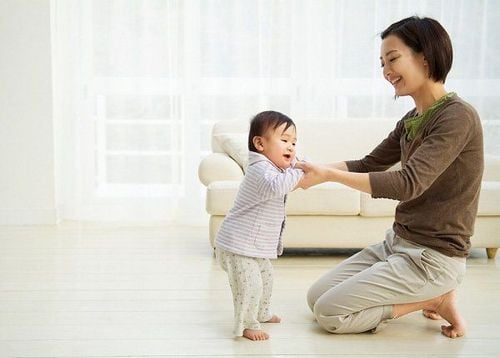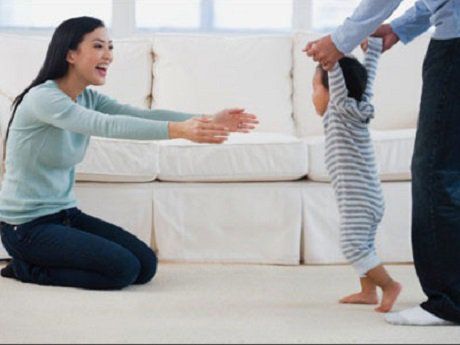This is an automatically translated article.
The time when children start to learn to stand, walk, and sit is extremely variable. Some babies walk before 9 months of age while others have to wait until 18 months or older. So should children learn to walk early, learn to sit early or learn to stand early?
1. Should children practice standing early?
Standing is an important milestone for both the child and the parent. This important skill helps babies develop their arm and leg muscles and gives them a whole new perspective on the world around them. Plus, standing is the first step for kids to walk and run, which means they'll soon become much more active.
According to the Denver II developmental milestone chart, infants can usually begin to:
Stand, hold on to objects between 6 and a half to 8 and a half months Stand up on their own for about 2 seconds upon reaching 9 to 11 and a half months Standing unaided between 10 and a half to 14 months However, only about 25% to 90% of babies learn to stand on their own, the remaining 10% will learn to stand a few weeks later or a month or two later. Usually, babies can stand on their own by the time they are 18 months old.
Parents often worry if their child is not on the developmental milestones. Learning to stand later than usual is not synonymous with long-term developmental abnormalities in the child. In particular, it is normal for the developmental milestones in premature babies to be later than in full-term babies.
Should children practice standing early? Newborns learn these skills instinctively, which means parents don't need to do anything to help their baby other than bring them in for regular check-ups and give them the opportunity to work on emerging skills. of children. Children should not be forced to practice standing early, especially when the child's body is not ready.
2. Should children learn to walk early?
Babies can take their first steps within days or months of being able to stand. But in the early stages, children can only hopscotch or walk. Children need more practice time.
Some babies can walk before they are 1 year old, but many others can walk after their first birthday, around 14 months on average. Babies can usually take their first few steps after they already know how to stand clinging to a coffee table or couch around September or October.
When kids are able to get up on their own without leaning on objects around them, it could mean that parents are about to get to see some of the baby's first toddler steps. If your child can't walk by 18 months, take him to the doctor to find out the cause of the delay.

Có nên cho trẻ tập đi sớm là thắc mắc của nhiều bậc cha mẹ
3. Should children learn to sit early?
Sitting up helps children become more independent and explore their environment in new ways. Sitting is an intermediate stage leading to other important developmental milestones, such as the beginning of crawling, crawling, standing, and walking.
Your baby's gross motor skills come into play while he learns to sit up. "To be able to sit up, babies need strong muscles in the neck, shoulders, abdomen, back and hips," says Jean Moorjani, M.D., a pediatrician at Arnold Palmer Children's Hospital in Orlando. As your baby becomes more efficient at using his hands to interact with the environment while sitting, the development of fine motor skills will also begin.”
Initially, babies will get used to sitting up with minimal support which means they have the proper muscle control needed to transition from a liquid diet of breast milk or formula to formula. “Children cannot transition to solid foods if they cannot sit up straight and keep their head and neck up,” says Dr. Moorjani. The sitting position helps children avoid choking or choking on food.”
When does the baby start sitting up?
Normally, babies can learn to sit from 4 to 7 months. But parents should not try to rush. According to pediatrician Kurt Heyrman, M.D., “Children need to have a number of specific motor skills before they reach this important milestone — like the ability to tilt their head back and keep their balance. Children should not be taught to sit early. Your baby's body needs to get ready to sit up.”
How to get your baby to sit up:
To help your baby sit up, try holding your baby's arm when he's on his back and gently pulling him up sitting position. Children will usually love the back and forth movement, so add some fun sound effects to make things even more interesting. When you see that your child can hold his head more firmly and he is able to lift himself to higher positions, help him sit up with assistance for 5 to 10 minutes a few times a day. Place your baby on your lap with their head and back against your chest, place them in a child support seat (follow all safety precautions) or use a pillow to lift them up. After the baby can sit alone, you need to make adjustments in the design of the baby's room. By the time your baby is 6 months old, your baby will usually have everything in sight, so check the environment around the crib and put dangerous items out of reach. Also, always make sure the child won't fall off the chair, bed or any other furniture.

Có nên cho trẻ tập ngồi sớm cần dựa vào độ tuổi của trẻ
4. Children with developmental delays and warning signs
While major developmental milestones such as standing, walking, and sitting may come a little earlier or later than average, prolonged delays are unusual and can be a cause for concern. concerns, is called retardation.
Your child's pediatrician will assess your child's progress towards these milestones at regular checkups. If your child's skills are behind the norm, the doctor will assess whether there are health problems in the child.
Some medical conditions can cause delay in standing or walking including:
Down syndrome Cerebral palsy Bone and joint problems, congenital orthopedic Muscular dystrophy So that your baby can develop well physically Both physically and mentally, parents should know the important milestones to accompany and develop with their children. As soon as they detect abnormal signs in both physical and psychological health of their children, parents should take their children to reputable medical facilities for advice and examination. To help children develop motor skills, in addition to nutrition, parents should supplement children with supportive products containing lysine, essential micro-minerals and vitamins such as zinc, chromium, selenium, and B vitamins. help meet the nutritional needs of children. At the same time, these essential vitamins also support digestion, enhance nutrient absorption, help improve anorexia, help children eat well, and develop comprehensively.
Please regularly visit Vinmec.com website and update useful information to take care of your baby and family.













